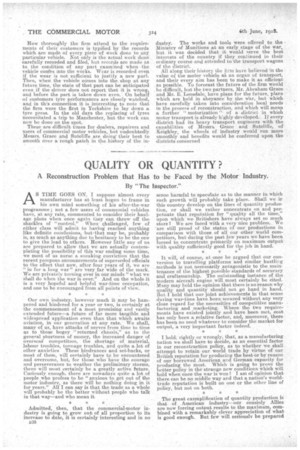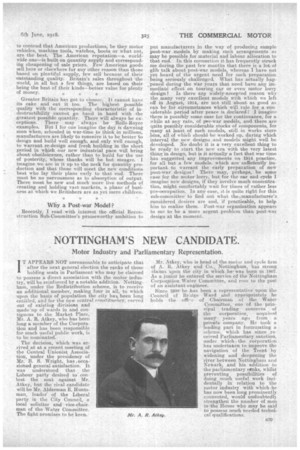QUALITY OR QUANTITY?
Page 16

Page 17

If you've noticed an error in this article please click here to report it so we can fix it.
A Reconstruction Problem that Has to be Faced by the Motor Industry.
By " The Inspector." By " The AS TIME GOES ON, I suppose 'almost every manufacturer has at least begun to frame in his own mind something of his after-the-war programme ; not a few users of commercial vehicles have, at any rate, commenced to consider their haulage plans when once again they can throw off the shackles of "control." When challenged, few of either cla,sa will admit to haying reached anything like definite conclusions, butothat may be, probably is, as much as anything due to hesitancy to be the one to give the lead to others. However little any of us are prepared to allow that we are actually contemplating the possibility of this war ending some time, we most of us nurse a sneaking conviction that the recent ponipous announcements of superseded officials to the effect that now, after four years of it, we are "in for a long war" are very far wide of the mark. We are privately turning over in our minds "what we shall do when the war is over." And on the whole it is a very hopeful and helpful war-time occupation, and one to be encouraged from all' points of view.
Our own industry, however much it may be hampered and hindered for a year or two, is certainly at the commencement of a most promising and vastly extended future—a future of far more tangible and widespread application even than that which awaits aviation, in our generation at any rate. We shall, many of us, have attacks of nerves from time to time as to those bogey "returned chassis," as to the general shortness of money, the increased danger of overseag competition, the shortage of material, labour troubles, tonnage troubles, and quite a lot of other anxieties. These hindrances and set-backs, or most of them, will certainly have to be encountered and overcome, but, for those who have the courage and perseverance to weather the preliminary storms, there will most certainly be a greatly active fature. Curiously enough, there are nowadays quite a lot of people who profess to be "anxious to get out of the motor industry, as there will be nothing doing in it for years," All I can say is that the trade as a whale will probably be the better without people who talk in that way—and who mean it.
Admitted, then, that the commercial-motor industry is going to .grow out of all proportion to its increase to date, it is certainly interesting and in no B38
sense harmful to speculate as to the manner in which such growth will probably take place. Shall weir this country develop on the lines of 4uantity production, or shall we rather concentrate on and perpetuate that reputation for "quality all the time," upon which weBritishers have always set so Much store 1 We are faced with a very -nice problem. We 'are still proud of the status of our productions in comparison with those of all our other world competitors, but during the past few years we have been forced to concentrate primarily on maximum output with quality sufficiently good for the job in hand:
It will, of course, at once be argued that our conversion to travelling platforms and similar hustling methods is not neeessarily antagonistic to the maintenance of the highest possible standards of accuracy and craftsmanship. The outstanding instance of the modern aircraft -engine will most certainly be cited. Many may hold the opinion that there is no reason why quality and quantity should not go hand in hand. But I hold that our joint achievements in that sense during war-time have been secured without any very close regard for the necessities of competitive manufacturing and Marketing. Where the two require' relents have existed jointly and have been met, cost has only been a relative factor, and, moreover, there has been no need whatever to consider the market for output, a very important factor indeed.
I hold, rightly or wrongly, that, as a manufacturing nation we shall have to decide, as an essential factor in our reconstruction policy, as to whether we shall attempt to retain our world trade by virtue of our British reputation for producing the best or by reason of our borrowed American and German capacity for producing the most. Which is going to prove the better policy in the strange new conditions which will held when once the war is won I am of opinion that there can be no middle way and that a nation's worldtrade reputation is' built on one or the other line of policy, but not on both,
The great exemplification of quantity production is that of . American industry—oor cousinly Allies are now forcing output results to the maximum, combined with a remarkably clever appreciation of what is good enough. But few will seriously be prepared to contend that American productions, be they motor vehicles, machine tools, watches, boots or what not, are the best. The American reputation—a worldwide one—is built on quantity supply and eorresponcling cheapening of sale prices. Few American goods sell here or elsewhere for any other reason than those based on plentiful supply, few sell because of their outstanding quality: Britain's sales throughout the world, in all but a few things, are based on their being the best of their kinda---better value for plenty of money.
Greater Britain has got to choose. It cannot have its cake and eat it too. The highest possible quality with the corresponding characteristic of indestructibility cannot go hand in hand with the greatest possible quantity. There will always be exceptions. There may always be Rolls-Royce examples. Brut I for one imagine the day, is dawning soon when, schooled in war-time to think in millions, manufacturers are likely to conceive it to be better to design and build well enough, and only well enough, to warrant re-design and fresh building in the short period in which -our new industrial pace will bring about obsele-Scenee, rather than to build for the use of posterity, whose thanks will be but meagre. I imagine we are in it up to the neck for quantity production and that those will meet the new conditions best who lay their plans early to that end. There must be no nervousness as to absorption of output. There must be new and much more live methods of creating and holding vast markets, a phase of business at which we Britishers are as yet mere children.
Why a Post-war Model.?
Recently, I read with interest the official Re S con struction dub-Committee's praiseworthy ambition to
put manufacturers in the way of producing sample post-war models by making such arrangements as maybe possible for material and labour allocation to that end. In this connection it. has frequently struck me during the past few months that there is a lot of glib talk about post-war models, whereas I have not , yet heard of the urgent need for such preparation being seriously challenged. What has actually happened during the war years that need have any immediat6 effect on touring car or even motor lorry design? Is there any widely-accepted reason why the many very excellent models With which we left off in August, 1914, are not still about as good as can be for circumstances which will rule for aeonsiderable period after peace is declared? I imagine there' is possibly some case for the continuance, for a while at any rate, of pre-war models, and there are quite possibly considerable stocks of components, for many at least of sueh models-, still in works store all,of which should be worked up, during which Interval the new designs -and models might well be developed. No doubt it is avery excellent thing to be ready to start the new era with the-very latest thing in design, but is it actually a fact that war time has suggested any improvements on 1914 practice, for all but a. few models, which are sufficiently imPortant to warrant the early prepaaation of new post-war' designs? There may, perhaps, be some ease for the motor lorry, but for the car and cycle I imagine new designs, if they involve much concentration; might comfortably wait for times of rather less • pie-occupation. In any ea-se, it is quite right for this sub-committee to find out what. the ;manufacturer's considered desires are and, if practicable, to help him to realize them. Post-war organization appears to me to be a more urgent problem than post-war design at the moment.






















